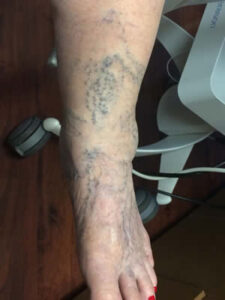Did you know that there are chronic venous insufficiency stages, and that more than half of adults over the age of 40 have some sort of varicose veins on their lower limbs? That's right, this is a progressive condition affecting your blood vessels. But, as it turns out, early-stage sufferers may not even know there's a problem!
In fact, the Clinical Etiology Anatomy Pathophysiology classification lists six distinct stages. They begin at C0, where you have no visible sign of vein disease. Next, at C1 you have noticeable spider veins. Progress to C2? Now, varicose veins emerge. By C3, you're worrying about edema. And if you get to C6? Well, at this point, you've got an active venous leg ulcer to address.
Now, all of that is really important information to understand. Especially if you've been delaying treating your spider veins. Do you hate how they look, but aren’t sure if there’s a good medical reason to get rid of them? If so, you NEED to read this blog post.
Why? Because, if left untreated, the vein problems you’re already experiencing will get worse. And that could lead to further medical complications. In fact, by the end of this post, we’re guessing you’ll be ready to talk vein treatment. But first, let's review three clear signs that pushing off your vein treatment is no longer an option.

Vein disease gets worse if left alone. So you should seek treatment in the early stages of vein disease. And, to help you do that, here are the different stops along the way to serious vein disease.
STAGE 1: You'll notice small red or blue veins under your skin. They may look like tree branches, and will be one millimeter or less in diameter. But, while they're small, they still mean your leg veins have leaky valves.
STAGE 2: Here come the varicose veins. At this stage, you may also develop symptoms. These include leg heaviness, itching, pain, inflammation, or even a ruptured vein, which can lead to bleeding events.
VENOUS INSUFFICIENCY STAGE 3: Edema becomes a problem. Your legs and ankles swell from pooling blood in your lower leg. Your skin may feel tight, or take on a leathery appearance.
STAGE 4: Your skin changes colors, especially around your calves and ankles. Again, this change comes from pooling blood in your lower legs.
STAGE 5: You may develop wounds (leg ulcers). While they may form scars, they'll be difficult to heal.
STAGE 6: Your ulcers could bleed (Venous stasis ulcers). They could also leak pus or fluid. They may give off bad odors. And they'll leave skin feeling tender or even burning. These ulcers also increase your risk for skin infections or even amputations in extreme situations.
As we mentioned, there are stages of vein disease. And, as with all progressive conditions, early treatment is best. So here are the clear signs it's time to seek vein treatment.
If you ignore varicose veins in the early stages of vein disease, they won’t stay the way they are. And they certainly won’t get better! Instead, these bulging veins will get larger and more dangerous. (See the six stages of vein disease above.)
So…that’s the bad news. But here’s the good: we can stop this progression in its tracks with proper vein treatments. Before recommending any of our vein treatments, our vascular specialists will perform a thorough exam and discuss all your available treatment options. Together, we’ll decide on the best way to stop your progressive vein disease in its tracks! So make your appointment today!
Source Page: https://texaseva.com/sources/

Scheduling
Please contact our dedicated specialists to schedule a consultation today.
2025 Texas Endovascular. All rights reserved. Website Design by Healthcare Success